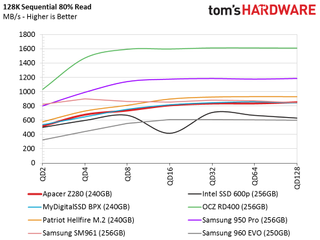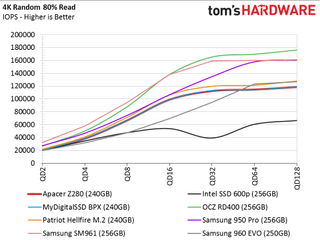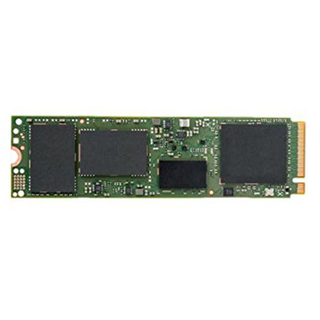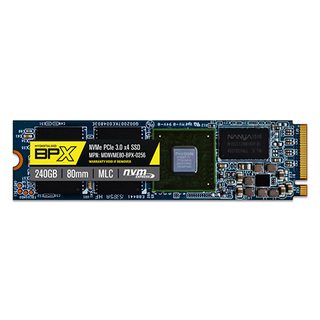Apacer Z280 NVMe M.2 SSD Review
Why you can trust Tom's Hardware
256GB SSD Performance
Comparison Products
The 256GB-class is the second most populated capacity point for consumer NVMe SSDs. Several companies choose to omit this size in the product line, just like the 128GB capacity. There is still no shortage of options available from both large and small SSD players. You won't have the 960 Pro lurking around here, but companies have built entry-level and mainstream products for this capacity.
Prices are more constrained in the 256GB-class. The Intel 600p 256GB starts off at $110.99, followed by the MyDigitalSSD BPX 240GB at $114.99. The Patriot Hellfire M.2 240G and Samsung 960 EVO 250GB will both set you back $129.99, and the OCZ RD400 256GB trails closely behind at $134.99. The Samsung 950 Pro 256GB rounds out the list at $179.99.
We included the Samsung SM961 256GB in the results. The series has resurrected itself with sparse availability throughout Europe, Australia, and North America. Pricing seems to be all over the place for the OEM series, but it's still one of the fastest 256GB-class NVMe SSDs on the market.
Sequential Read Performance
To read about our storage tests in-depth, please check out How We Test HDDs And SSDs. We cover four-corner testing on page six of our How We Test guide.


We include three Phison E7-based drives in our test pool. The Patriot Hellfire M.2 joins the BPX and the Apacer Z280. All three drives follow the same trajectory throughout the sequential read test, which scales queue depth to increase workload intensity.
Sequential Write Performance


The BPX and Z280 240GB deliver the same sequential write speed, but the Patriot Hellfire M.2 240GB has a 100 MB/s advantage for most of the test. All of the E7 drives outpace the two TLC-based drives. The 600p has a disadvantage, and the 960 EVO is hit or miss depending on the amount of space available for the cache.
Random Read Performance



Random read performance is one of the most important aspects because it has a direct impact on the user experience. We like to see high-performance SSDs with 10,000 IOPS at QD1, but it's difficult to achieve without an SLC cache. The NVMe protocol made it easier, but some SSD controllers still have trouble reaching the milestone. The Z280 240GB reaches just north of 9,200 IOPS at QD1, so it falls a bit shy, but it scales well as we increase the queue depth.
Random Write Performance



The Z280 240GB delivers average random write performance compared to other NVMe products. The drive scales well and quickly reels in some of the other products at mid-range queue depths, but it's often slower at low queue depths.
80 Percent Mixed Sequential Workload
We describe our mixed workload testing in detail here and describe our steady state tests here.

The Z280 480GB delivered an amazing amount of sequential mixed workload performance, but the 240GB drive is more reserved. You still get an acceptable level of performance, but it isn't the same explosive rush we recorded with the larger model.
80 Percent Mixed Random Workload

The Z280 and BPX follow the same trajectory through the mixed random test as they navigate right through the middle of the chart.
Sequential Steady-State



The E7 NVMe SSDs all deliver roughly the same level of performance in steady-state conditions. These drives are not ideal for heavy workstation use like the Samsung Pro models are, but they still deliver enough of a performance punch for mainstream use and even some occasional professional-level tasks.
Random Steady-State
Just like the larger models, the smaller E7 drives deliver high random write performance in steady state compared to SATA-based SSDs, but it's not very consistent. The Z280’s performance lines up with its price and mainstream NVMe standing.
PCMark 8 Real-World Software Performance
For details on our real-world software performance testing, please click here.










These are fairly light workloads, except for the extended Photoshop test, so the individual application results reveal very little variance between the NVMe SSDs. NVMe SSDs allow you to transfer data at high speed, but the application must make the requests to leverage the increased capabilities. NVMe SSDs have the ability, but the software hasn't caught up with the hardware.
Application Storage Bandwidth

The software requests the same data, in the same order, and from the same number of processor cores, so the results with NVMe SSDs are very similar. The lower latency accounts for the increased performance compared to SATA SSDs, but the software still isn't utilizing the drives to their full potential.
PCMark 8 Advanced Workload Performance
To learn how we test advanced workload performance, please click here.



SSDs slow down due to the dirty cells generated during a heavy workload, and performance remains low until the SSD controller refreshes the NAND pool. During idle time, the SSD controller cleans cells for incoming fresh data, which increases overall performance. In this series, we focus on the moderate workload that tests five recovery stages. Other than the Intel 600p, all the NVMe SSDs perform very similarly.
Total Service Time



The service time tests show how latency increases under heavy workloads with TLC-based drives. Those products can perform similarly to MLC-based drives under light workloads, but MLC is the better solution when you need reliable high performance to stand up against stressful workloads. The Z280 scores well in the moderate recovery tests, and it is one of the best low-cost NVMe products available.
Disk Busy Time

Just like with the larger models, the disk busy time test doesn't give us a lot of insight into the E7's power consumption. There are other issues with this controller that consume more idle power than many of the other drives.
Responsiveness Test


The Apacer Z280 scores well in the responsiveness test, but it consumes more power to deliver a smooth user experience.
Notebook Battery Life


As we've mentioned, the Phison PS5007-E7 consumes more power during idle states, and that translates to poor notebook battery life in our test with BAPCO's MobileMark 2014 v.1.5. Before we started using this test to focus on real-world battery performance with SSDs, no one would have thought a single storage device could reduce your notebook battery time by 100 minutes or more.
Stay on the Cutting Edge
Join the experts who read Tom's Hardware for the inside track on enthusiast PC tech news — and have for over 25 years. We'll send breaking news and in-depth reviews of CPUs, GPUs, AI, maker hardware and more straight to your inbox.
-
serendipiti Just wondering if it's possible to install OS and boot from NVMe drives (with PCIe adapters) on older motherboards by using one SATA HDD or SSD to start the windows loader and from there start the OS on the NVMe drive. The boot time would suffer, but then you should get the OS running from the NVMe drive. Not sure if there would be trouble with the drive letter assignment (but I've seen some smart cloning utilities that dealt with the drive letters reassignment)Reply
Going through a VM placed on the NVMe drive makes any sense ? -
svan71 https://forums.anandtech.com/threads/full-nvme-support-possible-for-older-intel-chipsets.2437588/Reply -
serendipiti svan71 thank you...Reply
Dealing with UEFI Bios firmware it's what I tried to avoid...
"As far that I know, there are several ways that you can use to load UEFI Drivers. One of them is having the UEFI Drivers integrated in the Firmware, which is what you did, but they may also be loaded as files from a disk's EFI System Partition. A previous idea I had was that you could format an USB Flash Drive in GPT with an ESP containing the NVMe Driver EFI executable, which could be loaded by UEFI, so it can provide NVMe support on older platforms. However, I don't recall anyone testing that way. Not even close as good as integrating them, but if it fails, it may also be worth a try." -
Bruce427 @ Chris,Reply
I purchased a 240GB MyDigital BPX around Thanksgiving on 2016.
It is likely that I have the latest firmware update? And if not, where can I download it?
Thank you,
Bruce -
Bruce427 Where can the latest firmware be downloaded? I didn't see it on MyDigital's website under firmware updates.Reply



